Also, Stories attract us; abstract details repel us.
Story contains 5 Ws:
- What - Plot is a sequence of related events that are caused by characters and their choices
- Who - Characters, what they do for living, what they try to accomplish
- When - Time period, lore, structure(Ex: non linear story telling)
- Where - Setting, world building, Point of views
- Why - Emotional stakes. What matters to the characters in your story.

Key ingredients of a story:
1. Character:
- The purpose of a character in a story is that audiences can learn how to live a better lives.
- They need to get invested into someone. They can learn from the character’s mistakes, learn from how they overcome the obstacles.
- Internal journey - They have a character flaw and how they overcome it. It is optional.
- Goals(What) and Motivation(Why) is mandatory.
2. Plots:
- Plot is a sequence of related events that are caused by characters and their choices
- It is the external journey the character undergoes.
- Main plot(Hero vs Villain) vs Sub plot(Challenge hero to grow)
- Should have stakes. Should be raising the stakes throughout the story. They should have more to gain and more to loose.
3. Concept:
- Its the central or the selling point of your story.
- Ex: In Harry potter, it is the idea of going to be the Wizarding school.
- It paints a picture of what the story is about.
- Low Concept: Basic concept. Friends living in a town.
- High Concept: Fresh “What if” concept. Ex: What if a chemistry teacher went rouge and decided to start cooking meth in Breaking Bad.
- Premise: Concept + Character + Conflict. Ex:
Scientistsvisit adinosaur theme parkandget trapped due to a major storm.
4. Conflict:
- It is the disagreement between two or more sides.
- It is very important as audiences love to find out how conflict gets resolved.
- Situation: Caused by character’s desires. Two characters wants the same thing or one wants to prevent another character from getting something they want.
- Action: Because of action, action must be taken. Solve or create problems. Dialogue is action. Its a action in the form of spoken word and you want to have your characters attacking and defending. They are trying to get information out of each other, trying to hide information, trying to give orders, trying to fight back against those orders.
5. Scenes:
- It is a basic unit of storytelling.
- Goal oriented scenes:
- Goal - char has a goal
- Conflict - face a conflict
- Disaster - eventually things end in disaster as a result of pursuing that goal and trying to overcome those obstacles.
- Reaction oriented scenes:
- Reaction - emotional reaction to the disaster in the goal scene.
- Dilemma - then they face a dilemma.
- Decision - they have to make a decision and pursue another goal.
6. Structure:
- Without a structure, it is a poem.
- Its the skeleton of your story.
- A story need a beginning, a middle and an end.
- Popular ones: 3 act, 5 act, save the cat beatsheet, Dan Harmon’s story circle, the eight sequences, etc…
7. Pacing:
- Speed at which your story is told.
- Genre determines it.
- It should be changing over the course.
8. World building:
- Setting:
- Location, terrain, plants, animals, etc…
- Weather/Climate,
- Population
- Economics system, political system, etc…
- Society’s daily habits/rituals
- Lore:
- Histories
- Traditions
- Facts
- Stories(told within the stories)
9. Theme
- Underlying message of the story.
- Meaning beneath the surface.
- Ex in Jurassic park:
- Surface: Scientist escaping dinosaur park
- Themes:
- Dangers of tampering with nature
- Man vs Technology
- Age vs Youth
- Writer’s goal is to seek truth.
- Show both/all sides of an argument or scenario.
10. Style:
- Voice - writer’s personality on page/screen.
- Word choice, sentence structure, etc…
- Cutting between moments/scenes, etc…
- Tone - Attitude of story [Serious, Funny, Dark, etc…]
- Mood - Emotional temperature of a story.